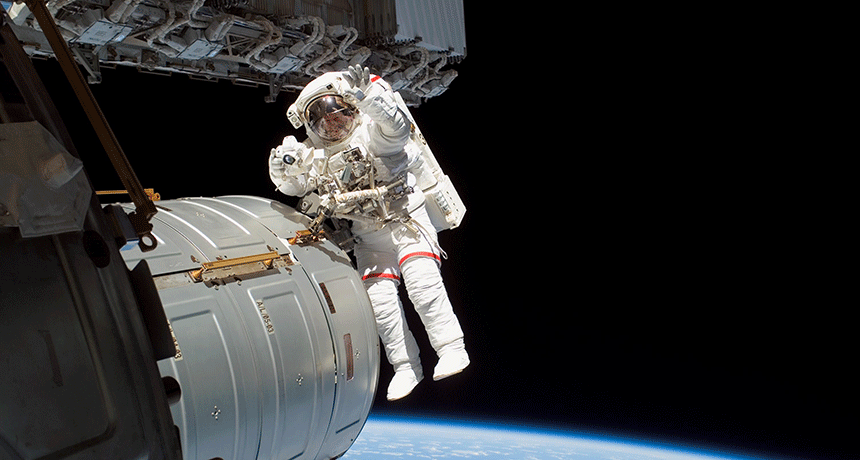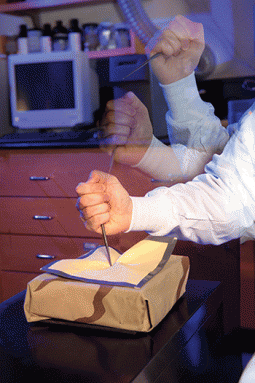Want a tougher space suit? Just add liquid
A new material might give astronauts better space suits that are strong, thin and light

Astronauts don bulky suits to protect themselves as they “walk” outside the International Space Station. A new material might one day make those suits even more protective.
NASA
By Marcus Woo
Space is dangerous. It’s filled with tiny rocks that can poke holes in an astronaut’s spacesuit. If oxygen leaks out of it, that space traveler is in trouble. To better protect space travelers, researchers are designing a new type of material to toughen those protective suits. And this material is about to get its first big test in space itself.
For a year, beginning sometime in 2018, the material will hang outside the International Space Station (ISS). When it returns to Earth, scientists will evaluate how well it withstood the real perils of space.
Today’s spacesuits are good enough for space walks that last only a few hours. But if tomorrow’s astronauts must spend more time in space — living and working on the moon or Mars, for instance — they will encounter more dangers. So they will need more-protective suits. “You can get hit by all kinds of things on the moon and Mars that you normally don’t worry about on Earth,” notes Norman Wagner. He works at the University of Delaware in Newark. He’s also one of the engineers designing the new spacesuit material.
Here’s the challenge his team confronted. A spacesuit needs to be tough. Still, its fabric must be thin and light enough to let astronauts easily move around. Ordinary fabric wouldn’t meet these needs, Wagner’s team realized. So it designed a new material that relies on a special liquid.
This substance is known as a shear-thickening fluid. Such fluids are remarkable. Hit one and it briefly turns solid. But left alone, it acts like a normal liquid.
Solid and liquid at once
Scientists have known about these fluids for decades. Silly Putty is one of these. You can even make one at home. Mix cornstarch with water and you get a goo called Oobleck. It oozes like thick gravy. But slap it with your hand and it feels hard. For the brief moment of impact, the gloop becomes solid.
(If you’re quick enough, you can even run across a huge pool of the stuff. You won’t sink because when your feet slap the mixture, all of those cornstarch particles, suspended in the water, jam together. These clumps form a solid, almost like how wet sand can be packed to form a sand castle.)

The new spacesuit material is called STF-Armor. It’s made from a strong plastic fiber called Kevlar. Wagner’s team soaks that Kevlar in a shear-thickening fluid. Instead of cornstarch, this fluid contains tiny ceramic particles that are smaller than the width of a strand of hair. How small is that? About 100 billionths of a meter in diameter.
After soaking, small droplets of this shear-thickening fluid embed themselves within the Kevlar fibers. Later, when something strikes the fibers, the tiny particles inside the droplets jam together. The fluid temporarily hardens, making the Kevlar fibers even stronger.
The researchers have already tested the material in the lab. They found that the material was better at withstanding stabs and cuts than the material now used for spacesuits.
How shear-thickening fluids switch between from liquid to solid and back again remains poorly understood, says Eric Brown. “That’s something we’re still investigating,” he notes — “the science behind why it is so good at absorbing impacts.” Brown is an engineer at Yale University in New Haven, Conn. He’s not part of the spacesuit project, but he does study shear-thickening fluids.
Mystery fluids may fend off micrometeorites
The ISS orbits more than 330 kilometers (200 miles) above Earth where it is not shielded by our thick atmosphere. Up there, tiny rocks occasionally zip past. Called micrometeorites, many are only about the size of sand grains. Still, flying about 20 times faster than a speeding bullet, they pose a risk to spacewalkers. Fortunately, they are not too common. You can spend months in space without getting hit by one. But some have struck a metal handlebar outside the ISS. The impact of one created a small crater with sharp edges that sliced into an astronaut’s glove.
Micrometeorites also strike the surface of the moon and Mars. Sharp rocks atop the surface of the moon and Mars pose their own dangers. Without a thick atmosphere like the one found on Earth, there’s hardly any wind to erode Martian or lunar rocks and dull their edges. As a result, some of the rocks can be sharp as knives. So they could easily cut or poke holes in a spacesuit if an astronaut fell on them. The suits worn by astronauts today just won’t hold up to this kind of wear and tear.
Wagner has long appreciated what these fluids have to offer. He co-founded a company called STF Technologies to develop shear-thickening fluids. They’re used for protective gear like bulletproof vests and football helmets. Now he and his company are helping NASA make spacesuits. (NASA is the National Aeronautics and Space Administration.)
The lab experiments on the new puncture-resistant fabric are promising, Brown says. But still more tests are needed. After all, a fabric failure could seriously injure, or even kill, an astronaut.
If the yearlong experiment at the space station goes well, real spacesuits could go into production in as soon as five years, Wagner predicts. And maybe, someday, you will wear them while walking on Mars.







